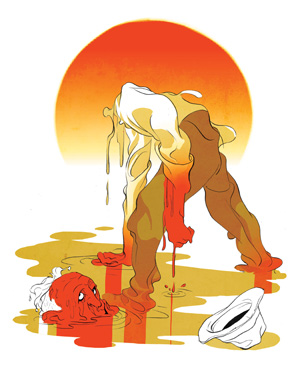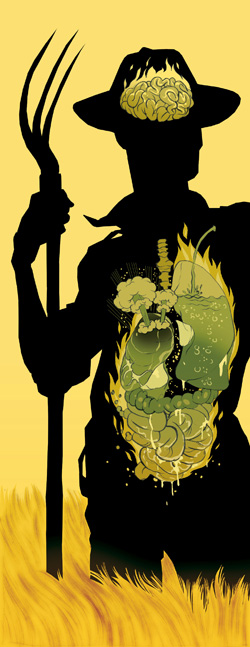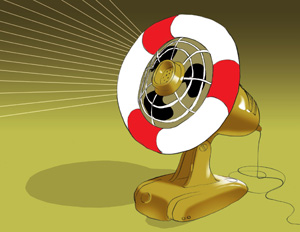California's summer disaster: 138 dead
By TRACIE WHITE
Hell week.
That’s what the workers in the Fresno morgue now call the period last summer when the bodies piled up so high that the stench stuck in their pores, impervious to soap and showers. By Monday morning, July 24, at a staff briefing, they pretty much knew that they were in the middle of a heat wave unlike any they had seen before. “Holy shit, here we go,” Amy Hance, deputy coroner, remembers thinking as the temperature reached 113 degrees by the afternoon and broke the record of 111 set in 1906.
Tomer Hanuka |
|
 |
|
It would be the third day temperatures reached 110 or above.
Working without air conditioning in full protective garb — mask and scrubs — the staff struggled to process the growing number of bodies filling the walk-in refrigerator, and determine cause of death. As the temperatures outside continued to break records, so did the temperatures of the bodies arriving inside the morgue. Body temps reached 109 degrees, 110 degrees. “Hey, we’ve got another one,” someone would yell as yet one more body was rolled in. A single swamp cooler, poor cousin to an air conditioner, mounted high in a corner of the examination room worked overtime to keep the temperature inside down in the 90s. The staff kept working though their clothes were wringing wet.
By Tuesday, the walk-in refrigerator had surpassed its capacity of 50 bodies, peaking at 67. Workers loaded the corpses onto gurneys two, sometimes three at a time. The stench of the dead permeated clothing, skin, then rose to the second floor as a silent reminder to those working in administration above of the carnage below. Hance went home after a 12-hour shift, showered for an hour, threw away all her clothes right down to her shoes and still couldn’t get the stink to go away.
The victims tended to be elderly, living on a fixed income, male and reluctant to turn on air conditioning, even when they had it. One was found alone in bed, a ceiling fan circulating air that reached 125 degrees. Another dropped dead in front of the Fresno Rescue Mission. And there was Richard “Dixie” Helmuth, 79, a farmworker who drove a tractor all day in the grape fields before finally collapsing. After more than 60 summers spent toiling under a blazing San Joaquin Valley sun, the weathered old bachelor figured he could beat the heat. This time he was wrong.
Disasters waiting to happen
Tomer Hanuka |
|
 |
|
They call heat waves “invisible natural disasters.” They sneak up and surprise, then shock entire communities. Soaring body temperatures destroy brain cells before victims even know they’re sick. The dead get carried away in body bags, stacked up in morgues and counted by coroners with little fanfare. There’s no dramatic television footage to run, no homes destroyed by hurricanes, no bodies buried in the rubble of earthquakes. Most deaths occur at home, the victims — often the elderly and the dispossessed — alone, their bodies starting to decompose before anyone finds them.
According to the official count, California’s heat wave this summer killed 138 people — two-thirds of them in the Central Valley — more than both the Loma Prieta earthquake and the Northridge earthquake combined. Many more deaths may have gone uncounted. Yet no state of emergency was ever declared, no emergency plan was set in motion. From public officials to the victims themselves, few realized the degree of danger they faced. You just don’t complain about the heat if you live in the Central Valley where triple-digit heat is a fact of life during the summer.
Your average Central Valley heat wave will last eight to 10 days and reach temperatures of 104 or 105. But this heat wave messed things up. In Fresno, temperatures climbed above 105 for 12 days and, unlike past hot spells, the nights just didn’t cool down. Many kept air conditioning off to save on electric bills, closed windows at night to keep out burglars and waited patiently for temperatures to drop. Some never got up the next morning.
California isn’t the first place to be shocked by a heat wave. More frequent and more intense deadly heat waves are occurring worldwide due to a number of factors, global warming prime among them. Scientists are no longer alone in saying we need to be prepared. Public officials, too, are finally waking up to an impending disaster.
A heat wave in New York last summer killed 100 people, the deadliest there in decades. Europe’s deadly heat wave of 2003 killed 35,000, its victims the elderly living quietly in beautiful Renaissance buildings that lacked ventilation or air conditioning — their adult children away on annual summer vacations. The Chicago heat wave of July 1995 took 700 lives, the numbers of its victims initially swept under the rug.
Climate change is occurring on a broad scale worldwide, melting ice caps, decimating grasslands, altering rain patterns. But among the most potentially deadly future changes will be heat waves of greater intensity and with record-breaking nighttime temperatures.
“Everything — their intensity, their length and the number of occurrences — worsens all around the world,” says Claudia Tebaldi, PhD, a statistician at the National Center for Atmospheric Research and lead author of a recent report in the journal Climate Change that forecasts future climate change based on simulations created on supercomputers in France, Japan, Russia and the United States. “The scariest results had to do with heat waves and warm nights. It’s these extremes, not the averages, that cause the most damage to society,” says Tebaldi, at Stanford now as a visiting researcher at the Center for Environmental Science and Policy.
Still, the deadly outcome of these heat waves isn’t due to global warming alone.
Increased temperatures caused by the insulating effect of urbanization, combined with social issues such as the growing isolation of a burgeoning elderly population, have created a recipe for disaster.
How the sun kills you
On Tuesday, the hottest day of the heat wave, temperatures reached 114 degrees, the fourth day in a row that temperatures topped 110 degrees. But not even that could stop Dixie Helmuth from finishing out the work day. As usual the old farmworker was the last to leave the grape fields just east of Fresno where he’d worked since high school. Every other farmhand had quit early seeking out the nearest air conditioning or shade.
Over the past six decades, driving a tractor in the wind, rain and blazing sun of the San Joaquin Valley, Helmuth rarely missed a day of work. Temperatures of 104, 105 degrees didn’t faze him. The 79-year-old bachelor was used to it. He wore the same long-sleeved work shirt and bib overalls working sunup to sundown. The sweat of his brow, he figured, would cool him down.
What Helmuth didn’t figure was that if the temperature got too high, higher than he’d ever seen it, his body’s natural cooling system could break down. In 114-degree heat, the sweat of his brow could somehow remain dry. And it could kill him.
“The last time I visited him, I said, ‘Let me know when you’re going to retire,’ ” says Dixie’s brother Jake Helmuth, 77, who lives in Chicago. The two grew up together just outside Fresno, working in the Del Rey raisin fields in the summer, playing high school baseball in the spring. Jake pitched. Dixie was his catcher. They remained lifelong buddies.
“You know, you’ve been working pretty hard,” Jake remembers saying to Dixie a few months before his death. “Isn’t it about time you retired?”
“I’ll finish out the season, then I’ll think about retiring,” he remembers Dixie answering. But Dixie never got the chance.
“He was a tough old ballplayer,” Jake says. “He had one more inning to go. I guess the heat finally caught up with him.”
It can take only 48 hours of uninterrupted exposure to intense heat before the body’s defenses begin to break down, says Eric A. Weiss, MD, assistant professor of emergency medicine at Stanford and an expert on heat illness. The longer a heat wave continues the more susceptible the body becomes to illness. Just a few hours of relief can break the cycle, which is why increased temperatures at night are so dangerous and why air conditioning is a life saver.
Heat illness results from dehydration at high temperatures. Dehydration causes the sweating mechanism to fail, eliminating the body’s natural cooling system. Body temperature may rise to 106 or higher in just 10 to 15 minutes. Heat stroke begins when people start to develop an altered level of consciousness, usually when their temperature rises above 105. Then the body starts to cook. First the brain cells die. Then the liver cells go. Fluid spills out into the lungs. If the body remains in the heat, the result can be coma and, finally, death.
As the fierce sun finally began to drop closer to the horizon Tuesday, the workday drawing to a close, a few of the young Mexican farmworkers still hanging around the Del Rey Packing Co. raisin fields noticed that even tough, old Helmuth was slowing down. His trademark straight furrows had begun to waver.
At about 6 p.m., Helmuth drove the tractor out to the dirt lot next to the rows of grapevines where he’d parked a brown Ford Taurus station wagon under the shade of a pecan tree. He climbed down from the tractor, opened the car door and collapsed into the driver’s seat, his brown-booted feet hanging limply out the driver’s door.
Population explosion
Tomer Hanuka |
|
 |
|
The agricultural fields surrounding the small town of Del Rey, where Helmuth was born and raised, stretch on acre after acre, flat and wide, the sky reaching down to touch the soil. But the telltale signs of the exploding population of the central San Joaquin Valley — which more than tripled to half a million during Helmuth’s lifetime — have begun to show even in this small farming community where family farms have survived for generations.
Today’s billboards lining the ever-growing network of freeways that crisscross Fresno County advertise in fancy, bold lettering its fastest growing crop: “New homes for sale, amazing prices.” Affordable housing is a hot commodity in California.
The same prime agriculture land that has drawn peach, almond, raisin and apricot growers to the Central Valley — still considered the agricultural heart of the state — is now attracting business and residential developers in droves.
Along with the Central Valley’s growth have come all the other trappings of a major metropolitan area — more cars, more concrete, more carbon dioxide and other greenhouse gases spewing into the air. Agricultural fields get replaced by strip malls. Evaporative cooling devices (aka swamp coolers) get replaced by air conditioning. It’s the same story of modernization that’s being repeated on a massive scale throughout the world. And it comes with a price tag.
“In general what’s happening is the Earth is less good at getting rid of heat because of the insulating effect of greenhouse gases,” says Chris Field, PhD, professor of biology at Stanford and founding director of the Carnegie Institution’s Department of Global Ecology. “The atmosphere works like a thick blanket trapping the hot air. The greater the concentration of greenhouse gases, the thicker the blanket, and the hotter it gets.”
California is expected to add 11 million new residents by 2030, and most of that growth is predicted to be in the hottest parts of the state — the Central Valley and the Inland Empire — where temperatures are typically 20 degrees higher than in coastal areas.
The growing urbanization creates what’s called an “urban island effect” that can further exacerbate heat levels by 5 to 10 degrees, experts say.
“We end up paving a lot of land and creating hotter surfaces, which create more heat islands,” explains Paul English, PhD, of the California Department of Health Services. “Along with more heat, more energy is needed for more air conditioning. Venting the hot air from the air conditioning creates more heat. It’s a vicious circle.”
Tepid response
By Tuesday, July 25, that heat had begun to kill people in California. The morning’s Fresno Bee reported 10 local deaths caused by the heat wave. The county was sending air-conditioned buses into rural neighborhoods and setting up cooling centers at libraries, community centers and schools. The death count continued to rise.
Similar scenes were repeated in the various counties up and down the Central Valley, as local governments struggled to respond as best they could to the mounting deaths. In the end, it proved to be too little too late, says state Sen. Dean Florez, a Democrat from the Central Valley who chairs the Senate Committee on Governmental Organization. After the fact, Governor Schwarzenegger set up the Emergency Heat Task Force in hopes of averting future heat wave tragedies, and Florez held a public hearing calling for the government to take a more active response.
A new state emergency heat plan now in place is designed to go into effect in the event of forecasted high temperatures, not after deaths begin to pile up. It includes opening state-run cooling centers — a first for California — initiating phone trees to alert the socially isolated of the dangers and calling nursing homes and hospitals before problems start.
“We acted like many of the folks out there who failed to turn on those air conditioners,” Florez told the committee at its Aug. 9 hearing. “We didn’t recognize the severity of the crisis. We thought we could handle it. And with each passing day, things tended to get worse. Bottom line, I think we were caught flat-footed.”
The hottest day
Many who brought victims into the morgue on Tuesday, the hottest day of the heat wave, spoke in tones of shocked disbelief of how they discovered the bodies. They looked like they were just resting. Manuel Lemus Fonseca, 63, was found dead sitting on his couch at home. He’d turned off the air conditioning to save money. Elbert Williams, 83, delivered to the morgue the same day, was found stretched out on his sofa. His girlfriend thought he was sleeping.
After they arrived at the morgue, the chief pathologist investigated each body. If the body was not decomposed, morgue workers took its temperature. To help determine cause of death, they drew blood, urine and, from the eye, vitreous fluid for lab tests and conducted autopsies if necessary. But most important for determination of cause of death were the details of how and where the bodies were found, the temperature of their surroundings, the stories of their deaths.
Just before 7 p.m. on Tuesday, 60-year-old Carlos Gonzalez, a friend and co-worker of Helmuth, was at his home watching the news on TV with his wife. The couple lived in a house out in the fields where Helmuth parked his car that morning.
The house was stifling so the couple went outside to see if the temperatures had started to drop. They noticed Helmuth’s car still parked. Carlos went to check on it. He found his friend collapsed inside, the driver’s side door open, a big Igloo water bottle next to him.
“Hey Dixie!” Carlos called out. There was no answer. Helmuth didn’t move.
“Call 911,” Carlos told his wife. “I think something’s wrong with Dixie.” Once on the phone, the dispatcher told them to check and see if he was still breathing.
“Hey Dixie, hey Dixie!” Carlos repeated again and again. He checked Helmuth’s neck. There was no pulse. His eyes were closed. He looked like he was asleep.
“Dixie’s dead,” Carlos said.
By Tuesday night, Helmuth’s body was on a gurney at the Fresno County morgue, just one more heat stroke fatality on the hottest day of the state’s hottest heat wave on record.
Comments? Contact Stanford Medicine at

